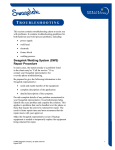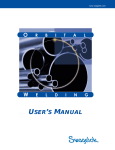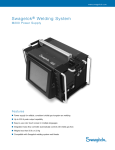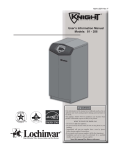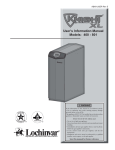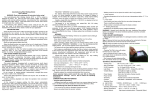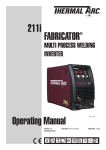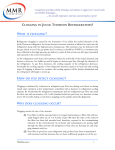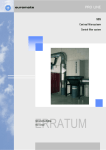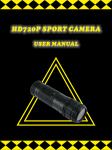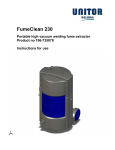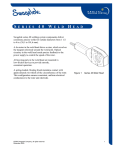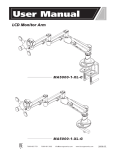Download Swagelok Welding System User Manual: Glossary
Transcript
GLOSSARY Active Procedure The procedure (sometimes referred to as Weld Program or Weld Schedule) that is loaded for use in the M100. This is the program that will be used in WELD mode functions. Arc The flow of electrical current between an anode and cathode. In welding, the flow of current between an electrode and the work. Arc Gap The distance between the electrode and the work. Arc Gap Gage The gage used to set the arc gap in the weld head rotor. Arc Radiant Energy The ultra-violet light emitted from the welding arc. Arc Start The period of the welding cycle following prepurge. During this short period of time, approximately 0.01 second, high voltage is applied between the electrode and work piece, initiating the arc. The only control of this period is with start power. Arc Welding A type of welding process that uses an electrical arc as a source of heat to melt and join metals. Arcing A condition in welding where the arc follows a path other than from the electrode to the work. This can cause damage to the weld head and fixturing components. Argon An inert monatomic gas used as a shielding and purge gas for gas tungsten arc welding. ©1999 Swagelok Company, all rights reserved August 2001 1 Glossary ATW (Automatic Tube Weld) A type of weld that uses a cuff at the joint of the weld fitting to aid in alignment and supply extra material to the weld joint. This weld will require more Arc Gap and more heat than a comparable Butt Weld. Autogenous In orbital welding, autogenous describes the process of welding two parts together using the fusion process without the use of filler material. Automatic Welding A welding process in which all of the parameters are controlled by the welding machine during the weld cycle. The process may or may not perform the loading and unloading of the work pieces. Average Current In pulse welding, high current is maintained for some fraction of each output cycle and low current is maintained for the remainder of the cycle. The average current is the sum of these fractional components that occur during each cycle. Backing Gas The gas used at the back of a weld joint or within a tube or vessel to prevent oxidation and undercut. Butt Weld A weld joint where two work pieces are welded together with their long axes concentric and in-line. The joint can have various configurations, such as square groove, v-groove, j-groove, double v-groove, etc. Centering Gage Gage used to center the work pieces in the fixture block. Ceramic Insert A ceramic insulator used in the rotor to isolate the electrode from the weld head. The insert helps prevent arcing. Collet A device used to hold the work pieces in the fixture. Collets are made in different sizes and shapes to accommodate different size and shapes of work pieces. 2 ©1999 Swagelok Company, all rights reserved August 2001 Glossary Concavity In welding, the condition where the weld profile extends below the outside surface of the work. Data Log Record This is the record of weld data such as the weld procedure used, the real time data output collected, information entered in WELD/INFO, and the acceptability performance of the weld. Data Logging Collecting welding parameter data regardless of faults or alarms. Data Monitoring Collecting data and comparing it to preset conditions. If the data is found to be outside normal limits, audio alarms may be triggered and a weld error message will be displayed. See the Power Supply module. Dedicated Line An electrical service line used for only one device. The device is isolated from interference created by other equipment and can utilize the full current capacity of the line breaker. GTAW An acronym for Gas Tungsten Arc Welding, the process used in the Swagelok Welding System (SWS). Heat Input The heat conducted into the weld during the weld cycle. It is generally expressed in joules or kilojoules (see Datalog Printout). Impulse (High Amps) The maximum current level generated during the weld cycle. Also referred to as high amps. Inches of Water Column (IWC) Unit of pressure measurement. 1 PSI= 2.31 ft. of water column= 27.72 in. of water column Inclusion A defect or discontinuity in the work material or weld that could become a site for stress or corrosion. ©1999 Swagelok Company, all rights reserved August 2001 3 Glossary Internal Purge Gas The backing gas used at the back of a weld joint or within a tube or vessel to prevent oxidation and encroachment. Jog The term used when positioning the rotor with the rotor JOG key before or after the weld cycle. Joule A unit of energy used to express heat input. One joule is equal to one ampere times one volt for one second. Also termed a watt-second. Level Factor A percentage of the level 1 impulse current used to calculate the impulse current drop in subsequent levels (Refer to Setting Single or Multi-Level Program Parameters in the Power Supply module). Maintenance (Low Amps) The minimum current level generated during the weld cycle. Also referred to as background current or low amps. Meander A welding condition in which the weld puddle is displaced to one side of the weld joint from the center line. Misfire An action that occurs when the arc fails to start or sustain itself. mm of Water Column Unit of pressure measurement. Multiple Level A welding technique in which more than one average current level is used during the weld time. Multiple Pass A welding technique in which the rotor moves more than one revolution during the weld time. The technique is most helpful when fusion welding small diameter parts. 4 ©1999 Swagelok Company, all rights reserved August 2001 Glossary Orbital Welding A welding technique used for tubing, pipes, etc. in which the arc rotates around the weld joint circumference. Oxidation Heat discoloration or heat tint that occurs in the weld area caused by the presence of oxygen. It can vary in color and intensity based on the weld temperature and the amount of oxygen present. Oxidation can be detrimental to high purity systems and increase the chances of weld joint corrosion. Ozone A gas produced when the ultraviolet light emitted by the welding arc reacts with the oxygen in the surrounding atmosphere. Penetration The term used to describe the depth of the weld. The common usage to describe the correct level of penetration for tube and pipe welds is “full penetration weld.” This means the weld has penetrated completely from the outside diameter to the inside diameter of the weld joint. There are no portions of the weld joint that are visibly unfused. Plenum A fixture block component that separates the side plates, providing space for the weld head and forming a chamber for the shielding gas. Postpurge The amount of time that the O.D. shielding gas is on after the welding is complete to cool the work pieces. Power Supply The device that produces the electrical power for the welding process. The SWS power supply is a constant current power supply. Prepurge The amount of time that the O.D. shielding gas is applied before the arc start. Pulse Rate The rate at which the output current level is changed between the high (Impulse) and low (Maintenance) settings. The rate is expressed as pulses per second. ©1999 Swagelok Company, all rights reserved August 2001 5 Glossary Pulse Weld A weld current that varies between a high level and a low level at a specific rate. The technique reduces the heat input to the weld. Pulse Width (% Impulse) The percentage of time during one cycle that the weld current is at the Impulse (High Amps) level. Purge Gas The gas (backing or shielding) used at the weld joint or within a tube or vessel to prevent oxidation. Ramp Ramp is a time entered into a weld level that allows a gradual amperage change from the previous level or Arc start current. (Refer to Weld Program with Ramp Time in the Power Supply module). Re-enforcement The excess metal on the outside of the weld extending above the surface of the work. Sometimes referred to as the “crown.” Remote Pendant A hand-held control device that allows remote operation of the SWS power supply. Rotor The device that holds the tungsten electrode and moves around the weld joint during orbital welding. Rotor Delay A time delay that is programmed into the weld procedure after arc start to allow the weld to penetrate the material by delaying the rotor movement. This should be carefully controlled in single pass welds. SCFH The acronym for standard cubic feet per hour. The unit used to measure the flow rate of shielding and purge gases. Shielding Gas The gas used to shield the tungsten electrode and work pieces during the welding cycle and cool the weld head. 6 ©1999 Swagelok Company, all rights reserved August 2001 Glossary Single Level A welding technique in which a single average value of current is used during the weld cycle. Single Pass A welding technique in which the rotor moves one revolution during the weld time. Socket A basic lap type of weld joint. Refer to Socket Welds in the Power Supply module. Solenoid Bypass An option that bypasses the internal gas solenoid in favor of a secondary valve and is controlled by the power supply. Speed Lo This is the rotor speed in RPM during the Maintenance portion of the weld cycle. (Refer to Step Programs Multi-Level in the Power Supply module). Speed Hi This is the rotor speed in RPM during the Impulse portion of the weld cycle. (Refer to Step Programs Multi-Level in the Power Supply module). Start Current The DC current used during the rotor delay. Normally the average current of level one of the weld procedure. Start Power The high voltage that starts the weld arc. The M100 has three settings, U-LOW for use with wall thickness of 0.010 in. (0,25 mm) or less, LOW for use with thin materials and the series 5 and 8 weld heads, and NORMAL for all other applications. Step Program A type of weld program in which the rotor speed is different between the impulse (high) pulse time and the maintenance (low) pulse time. The rotor speed may vary from zero to the weld heads maximum rpm. (Refer to Step Programs Multi-Level in the Power Supply module). Straight Polarity The electrical configuration that makes the electrode the negative lead and the work the positive lead. ©1999 Swagelok Company, all rights reserved August 2001 7 Glossary Tacks Small points of weld that do not penetrate the wall completely. Usually spaced at three or four places around the tube diameter. Used to hold the joint alignment and joint gap during welding. Travel Speed The speed of the electrode as it passes over the weld joint, usually expressed in inches per minute or millimeters per second. Travel speed is normally entered into the machine as RPM. Tungsten The material used to make the electrode. Tungsten is typically alloyed with rare earth metals to enhance its current-carrying capacity. UCI An acronym used for universal collet insert, the exchangeable component used in the fixture block to hold work pieces. The patented inserts come in various sizes to match the outside diameter of the work pieces. Warning (W:) A status line displayed on the M100 under the READY status line during the WELD/WELD mode. They do not disable the machine but are warnings to the M100 operator to an equipment condition that may affect the weld. (Refer to Weld- Disable, Warnings, and Weld Errors in the Power Supply module). Watt A unit of electrical power measurement. One ampere times one volt equals one watt. Weld Coupon A sample weld made for evaluation purposes. The weld is used for both visual and physical testing. Weld Pool Shift See meander. Weld Procedure The term used to describe a custom set of weld parameter values used to program the SWS for a particular welding job. The parameter settings are based on the characteristics of the work and the SWS configuration. It is sometimes called the “weld schedule.” 8 ©1999 Swagelok Company, all rights reserved August 2001 Glossary Weld Puddle The portion of the weld that is molten. Weld Time The portion of the weld cycle in which the current is at the level needed to fully penetrate the weld joint. The current will pulse between Impulse and Maintenance levels. ©1999 Swagelok Company, all rights reserved August 2001 9 Glossary 10 ©1999 Swagelok Company, all rights reserved August 2001










